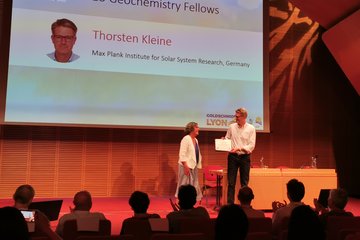Alle Typen
21.
Zeitschriftenartikel
Energetic particle bursts in the predawn Jovian magnetosphere. Geophysical Research Letters 25 (8), S. 1249 - 1252 (1998)
22.
Zeitschriftenartikel
Magnesium isotopic composition as observed with the CELIAS/MTOF experiment on the SOHO spacecraft. Journal Geophysical Research 103, S. 26805 - 26812 (1998)
23.
Zeitschriftenartikel
Determination of the neutral number density in the Io-torus from Galileo-EPD measurements. Geophysical Research Letters 25 (21), S. 4039 - 4042 (1998)
24.
Zeitschriftenartikel
On the dayside region between the shocked solar wind and the ionosphere of Mars. Journal Geophysical Research 103, S. 9101 - 9111 (1998)
25.
Zeitschriftenartikel
Quasi-periodic modulations of the Jovian magnetotail. Geophysical Research Letters 25 (8), S. 1253 - 1256 (1998)
26.
Zeitschriftenartikel
Elemental composition of January 6, 1997, CME. Geophysical Research Letters 25, S. 2557 - 2560 (1998)
27.
Zeitschriftenartikel
Rosetta Orbiter Spectrometer for Ion and Neutral Analysis - ROSINA. Advances in Space Research 21 (11), S. 1527 - 1535 (1997)
28.
Zeitschriftenartikel
A new, temporally confined population in the polar cap during the August 27, 1996 geomagnetic field distortion period. Geophysical Research Letters 24, S. 1447 - 1450 (1997)
29.
Zeitschriftenartikel
Particle acceleration in geospace and its association with solar events. Solar Physics 172, S. 287 - 296 (1997)
30.
Zeitschriftenartikel
First polar and 1995-034 observations of the midaltitude cusp during a persistent northward IMF condition. Geophysical Research Letters 24, S. 1475 - 1478 (1997)
31.
Zeitschriftenartikel
Venus tail ray observation near Earth. Geophysical Research Letters 24, S. 1163 - 1166 (1997)
32.
Zeitschriftenartikel
Isotopic composition of solar wind neon measured by CELIAS/MTOF onboard SOHO. Journal Geophysical Research 102, S. 26895 - 26904 (1997)
33.
Zeitschriftenartikel
Study of the solar wind deceleration upstream of the Martian terminator bow shock. Journal Geophysical Research 102, S. 2165 - 2173 (1997)
34.
Zeitschriftenartikel
Low energy (E < 400 eV) ions in the magnetosphere of Mars as measured by the HARP instrument on PHOBOS 2. Advances in Space Research 20, S. 169 - 172 (1997)
35.
Zeitschriftenartikel
The interaction of the shocked solar wind and the planetary ions at Mars. Advances in Space Research 20, S. 159 - 167 (1997)
36.
Zeitschriftenartikel
Magnetic field overshoots in the Martian bow shock. Journal Geophysical Research 102, S. 2157 - 2163 (1997)
37.
Zeitschriftenartikel
Quantitative model of the Martian magnetopause shape and its variation with the solar wind ram pressure based on Phobos 2 observations. Journal Geophysical Research 102, S. 2147 - 2155 (1997)
38.
Zeitschriftenartikel
RAPID: The Imaging Energetic Particle Spectrometer on Cluster. Space Science Reviews 79, S. 399 - 473 (1997)
39.
Zeitschriftenartikel
Energetic neutral atoms in the outer magnetosphere: An upper flux limit obtained with the HEP-LD spectrometer on board GEOTAIL. Geophysical Research Letters 24, S. 111 - 114 (1997)
40.
Zeitschriftenartikel
SWICS/Ulysses observations: The three-dimensional structure of the heliosphere in the declining/minimum phase of the solar cycle. Geophysical Research Letters 24, S. 2885 - 2888 (1997)











